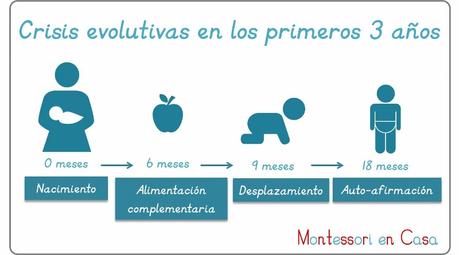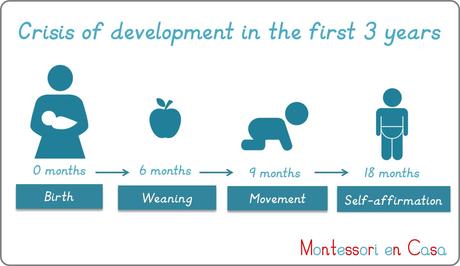
(scroll down for English)
Los 3 primeros años de vida son un periodo de máxima importancia en el desarrollo físico y psicológico del niño. Durante estos 3 años aparecen las llamadas crisis evolutivas, que son periodos de transición entre etapas con características concretas que debemos conocer y entender para poder ofrecer al niño nuestro apoyo de la mejor forma en función de sus necesidades cambiantes.
La palabra crisis suele tener una connotación negativa, pero su significado real es “juicio”, es decir, no debemos tomar estas crisis como periodos problemáticos que hay que pasar sin más, sino como periodos que ponen a prueba tanto al niño como a nosotros, y que tras pasar esa prueba el niño habrá dado un paso más en su evolución.
Crisis del nacimiento
En el nacimiento se produce la separación física del cuerpo de la madre. El bebé lleva 9 meses preparándose para esta prueba y en este momento debe demostrar que es capaz de respirar, de buscar el pecho de su madre, de poner en funcionamiento su sistema digestivo…
Durante las primeras 6-8 semanas de vida, el periodo simbiótico, el bebé necesita desarrollar un fuerte apego con su madre, se debe evitar la sobreestimulación y se debe favorecer la intimidad del núcleo familiar durante estas primeras semanas.
Durante este periodo el bebé se adapta a la vida fuera del útero y empieza a desarrollar su confianza en el entorno desde la seguridad de los brazos de su madre.
Al terminar este periodo el bebé está listo para empezar a interactuar con el mundo más allá de su madre.
Crisis de la introducción de alimentación complementaria
Alrededor de los 6 meses el bebé está listo para empezar a complementar la lactancia con otros alimentos. En esta crisis se pone a prueba la capacidad del niño para masticar y digerir nuevos alimentos, y para aprender a alimentarse solo.
Algunos de los signos que nos indican cuándo está preparado:
- Capacidad de sentarse solo
- Aparición de dientes
- Interés por la comida
La introducción de alimentos debe realizarse siempre respetando al niño, sin obligarle a comer ni introducirle la comida en la boca, sino poniéndosela delante y dejando que sea él quien se acerque a la cuchara. El método Baby Led Weaning también es una muy buena opción.
Crisis del desplazamiento
Alrededor de los 9 meses el bebé empieza a tener la capacidad de desplazarse, alejarse de la madre y después volver, primero mediante el gateo y más adelante andando. Con esta crisis se ponen a prueba las capacidades motoras que el bebé ha estado desarrollando desde el nacimiento (especialmente si no le hemos puesto impedimentos para ello).
En este periodo es importante transmitirle nuestra confianza con nuestro lenguaje corporal y nuestras expresiones, y no frenar ni forzar sus avances.
Suele coincidir que en este momento el bebé empieza a manifestar la “ansiedad ante los extraños”, debido a que ahora ya es consciente de su propio cuerpo y su propio espacio y no tolera que un desconocido invada ese espacio.
Crisis de auto-afirmación
Comienza alrededor de los 18 meses, cuando el niño empieza a utilizar la palabra “no” y termina cuando el niño empieza a utilizar la palabra “Yo”. Comúnmente se habla de este periodo como la crisis de los dos años.
Es un periodo en que el bebé está dejando de serlo para convertirse en un niño, por lo que en ciertos momentos se comporta como un bebé y en otros como un niño, lo que puede confundir a los padres y hacerles pensar que el niño es “caprichoso”.
Cuando el niño dice “no” está intentando reafirmar su opinión, dejar claro que ya no es un bebé que necesita que tomemos todas las decisiones por él, sino que es capaz de decidir sobre ciertas cosas. Un ejemplo muy claro es la ropa, en este periodo es muy beneficioso dar a elegir al niño entre dos camisetas en lugar de decidir nosotros. Para nosotros no supone un gran esfuerzo y para el niño supone una gran diferencia porque se siente escuchado, capaz y satisfecho.
Es importante entender y acompañar al niño en este periodo, ya que es el momento en el que se desarrolla su confianza en sí mismo (a diferencia de las etapas anteriores en las que se desarrollaba su confianza en el entorno).
En el momento en que el niño empieza a utilizar la palabra “Yo” termina la crisis de auto-afirmación porque esto significa que ya es consciente de que es un ser humano individual y único.
Te ha gustado?
Compártelo!
O déjame un comentario!
O haz las dos cosas!
—————-

The first 3 years are a period of utmost importance in the physical and psychological development of the child. During these 3 years there are some crisis of development, which are periods of transition between stages with specific characteristics that we must know and understand in order to offer the best support to the child and his changing needs.
The word crisis usually has a negative connotation, but its real meaning is “judgment”, ie we should not take these crises as problematic periods, but as moments that test both the child and us, and after passing that test the child will have taken another step in his evolution.
Crisis of birth
At birth the physical separation of the mother’s body occurs. The baby takes nine months to prepare for this test and now must demonstrate the ability to breathe, to seek the breast of his mother, to start digesting…
During the first 6-8 weeks of life, the symbiotic period, the baby needs to develop a strong attachment to his mother, we must avoid overstimulation and should promote intimacy of the family during these first weeks.
During this period the baby is adjusting to life outside the uterus and begins to develop confidence in the environment from the safety of his mother’s arms.
At the end of this period the baby is ready to begin interacting with the world beyond his mother.
Weaning crisis
Around 6 months the baby is ready to start supplementing breastfeeding with other foods. This crisis tests the child’s ability to chew and digest new foods, and learning to feed herself.
Some of the signs that tell us when the baby is ready:
- Ability to sit
- Appearance of teeth
- Interest in food
The introduction of foods should always be made respecting the child, without forcing him to eat or introducing food into the mouth. Baby Led Weaning method is also a very good choice.
Movement crisis
Around 9 months the baby begins to have the ability to move away from her mother and then back, first by crawling and later walking. With this crisis are tested the motor skills the baby has been developing since birth.
In this period it is important to convey our confidence in our baby’s abilities with our body language and our expressions, and not hinder or force his advances.
Also around this time the baby begins to manifest the “stranger anxiety” because now he is aware of his own body and his own space and does not tolerate a stranger invading that space.
Crisis of self-affirmation
It starts around 18 months when the child begins to use the word “no” and ends when the child begins to use the word “I”. This period is commonly called the “terrible twos”.
It is a period when the baby is becoming a child, so that at times he behaves like a baby and in others as a child, which can mislead parents into thinking that the child is “capricious”.
When the child says “no” she is trying to reassert her opinion, make it clear that she is no longer a baby who needs us to take all decisions for her, but who is able to make decisions on certain things. A clear example is clothing; in this period is very beneficial to let the child choose between two shirts instead of deciding it ourselves. For us there is a not great effort involved and for the child it makes a big difference because she feels heard, capable and satisfied.
It is important to understand and accompany the child in this period, as it is the time when self-confidence develops (unlike previous stages when confidence in the environment developed).
By the time the child begins to use the word “I” the crisis of self-affirmation ends, because it means he is aware that he is an individual and unique human being.

